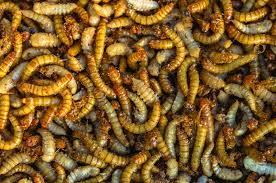Insect Feed Market Insights: Understanding the Drivers Behind Its Growing Adoption

The insect feed market has rapidly emerged as a transformative solution within the broader animal nutrition industry. As sustainability and efficiency become imperatives in the agri-food sector, insect-based feed is gaining momentum due to its environmental benefits, high nutritional value, and alignment with global food security goals. A closer look at the market reveals crucial insights into why insect feed is no longer just an alternative, but an essential component in the evolution of livestock and aquaculture production systems.
One of the most important insights driving market interest is the superior feed conversion ratio of insects compared to traditional livestock feed ingredients. Insects, particularly species like black soldier fly larvae (BSFL), crickets, and mealworms, require less land, water, and feed to produce the same amount of protein as soy or fishmeal. This efficiency allows producers to cut down on resource use while still meeting nutritional standards, offering both cost and environmental benefits.
Another pivotal insight is the strong alignment of insect feed with circular economy principles. The majority of insect-rearing operations rely on organic waste—ranging from food scraps to agricultural residues—as feedstock. This closed-loop model not only reduces reliance on virgin resources but also provides an effective solution for managing food waste. Companies adopting this approach contribute to global sustainability goals while lowering their input costs, which makes their operations more resilient in volatile markets.
Consumer insights further support the shift toward insect feed. There is growing public awareness of climate change, biodiversity loss, and the environmental footprint of traditional animal farming. As consumers demand more sustainable products, producers are under pressure to demonstrate environmental responsibility. Insect feed provides a compelling narrative for sustainability-conscious buyers, particularly in aquaculture and pet food, where clean-label and eco-friendly sourcing are increasingly valued.
Additionally, governments and international bodies are recognizing the value of insect feed and offering both regulatory support and financial incentives. The EU, for instance, has relaxed its rules to allow insect protein in pig and poultry feed and has allocated research funding to insect farming. Insights from regulatory developments indicate that governmental backing is critical in facilitating market entry and expansion, particularly in developing economies and emerging markets where protein demand is rising sharply.
On the production side, a critical insight lies in the role of technological innovation. Automation, vertical farming, and data analytics have revolutionized insect farming, allowing for higher yields, standardized quality, and reduced labor dependency. These technologies are enabling a shift from pilot-scale operations to full industrial production. As companies invest in R&D, they are unlocking new efficiencies that bring down production costs and open up broader markets.
There is also a strategic insight in the diversification of insect feed applications. Originally focused on aquafeed, the market has expanded into poultry, swine, and pet food, each with specific nutritional and functional benefits. For example, insect protein enhances gut health and immune function in poultry, while its hypoallergenic nature makes it ideal for sensitive pets. This cross-sector relevance broadens the market opportunity and lowers risk by not being dependent on a single customer segment.
Supply chain insights also underscore a maturing industry. As more players enter the market, from raw material suppliers to end-product manufacturers, an integrated value chain is taking shape. This integration allows for greater consistency, traceability, and collaboration across stakeholders, which is vital for building consumer trust and achieving economies of scale. It also paves the way for long-term contracts and strategic partnerships that ensure demand stability and investment security.
Financial insights point to a healthy influx of venture capital, private equity, and institutional funding. Investors are drawn to the sector’s sustainability profile, scalability, and the potential to disrupt conventional feed markets. Large agribusinesses and food conglomerates are also making strategic acquisitions or forming partnerships with insect protein startups, signaling long-term commitment to alternative feed solutions.
Finally, geographic insights indicate uneven but promising global adoption. Europe remains a leader due to strong regulatory frameworks and sustainability policies, but Asia-Pacific and Latin America are catching up quickly. The sheer size of the aquaculture industry in these regions, combined with favorable climatic conditions for insect farming, suggests a significant growth runway. Africa, too, is exploring insect feed as a means to address food insecurity and promote rural entrepreneurship.
In conclusion, the insect feed market is underpinned by a range of compelling insights—from environmental efficiency and regulatory support to consumer preference and technological innovation. These factors collectively indicate a strong and sustainable future for insect-based animal nutrition. As global protein needs rise and sustainability pressures mount, insect feed offers a viable and impactful solution that is both economically and ecologically sound. Stakeholders who act on these insights stand to gain early-mover advantages in an increasingly competitive and purpose-driven industry.
- Art
- Causes
- Crafts
- Dance
- Drinks
- Film
- Fitness
- Food
- Παιχνίδια
- Gardening
- Health
- Κεντρική Σελίδα
- Literature
- Music
- Networking
- άλλο
- Party
- Religion
- Shopping
- Sports
- Theater
- Wellness


